Karst Collapse Risk Zonation and Evaluation in Wuhan, China Based on Analytic Hierarchy Process, Logistic Regression, and InSAR Angular Distortion Approaches
Abstract
1. Introduction
2. Study Area and Materials
2.1. Study Area
2.2. Materials and Data Layers Grading
3. Methodology
3.1. The AHP-Based Approach to Risk Assessment
3.1.1. Decision Matrices and Consistency Test
3.1.2. Karst Collapse Susceptibility and Risk Assessment
3.2. The LR-Based Approach to Risk Assessment
3.3. The Weighted Angular Distortion Approach to Risk Assessment
4. Risk Zonation Results
4.1. Risk Zonation by AHP-Based Approach
4.2. Risk Zonation by LR-Based Approach
4.3. Risk Zonation by InSAR-Based Angular Distortion Approach
5. Discussion
5.1. Comparison of Karst Collapse Risk Zonation Results
5.2. Zoning Results Test and Model Evaluation
5.3. Analysis of the Applicability of Three Approaches on Karst Risk Zonation
6. Conclusions
Author Contributions
Funding
Data Availability Statement
Acknowledgments
Conflicts of Interest
References
- Waltham, T.; Bell, F.G.; Culshaw, M. Sinkholes and subsidence: Karst and cavernous rocks in engineering and construction. In Springer-Praxis Books in Geophysical Sciences; Springer: Berlin/Heidelberg, Germany, 2005. [Google Scholar]
- Gutiérrez, F.; Parise, M.; De Waele, K.; Jourde, H. A review on natural and human induced geo-hazards and impacts in karst. Earth Sci. Rev. 2014, 138, 61–88. [Google Scholar] [CrossRef]
- Baer, G.; Schattner, U.; Wachs, D.; Sandwell, D.; Wdowinski, S.; Frydman, S. The lowest place on Earth is subsiding-an InSAR (interferometric synthetic aperture radar) perspective. Geol. Soc. Am. Bull. 2002, 114, 12–23. [Google Scholar] [CrossRef]
- Kim, J.-W.; Lu, Z.; Kaufmann, J. Evolution of sinkholes over Wink, Texas, observed by high-resolution optical and SAR imagery. Remote Sens. Environ. 2019, 222, 119–132. [Google Scholar] [CrossRef]
- Dahm, T.; Heimann, S.; Bialowons, W. A seismological study of shallow weak micro-earthquakes in the urban area of Hamburg city, Germany, and its possible relation to salt dissolution. Nat. Hazards 2011, 58, 1111–1134. [Google Scholar] [CrossRef][Green Version]
- Gutiérrez, F.; Galve, J.P.; Lucha, P.; Cadtañeda, C. Integrating geomorphological mapping, trenching, InSAR and GPR for the identification and characterization of sinkholes: A review and application in the mantled evaporite karst of the Ebro Valley (NE Spain). Geomorphology 2012, 134, 144–156. [Google Scholar] [CrossRef]
- Intrieri, E.; Gigli, G.; Nocentini, M.; Lombardi, L.; Mugnai, F.; Fidolini, F.; Casagli, N. Sinkhole monitoring and early warning: An experimental and successful GB-InSAR application. Geomorphology 2015, 241, 304–314. [Google Scholar] [CrossRef]
- Ng, A.H.M.; Wang, H.; Dai, Y.; Pagli, C.; Chen, W.; Ge, L.; Du, Z.; Zhang, K. InSAR reveals land deformation at Guangzhou and Foshan, China between 2011 and 2017 with COSMO-SkyMed data. Remote Sens. 2018, 10, 813. [Google Scholar] [CrossRef]
- Vajedian, S.; Motagh, M. Extracting sinkhole features from time-series of TerraSAR-X/TanDEM-X data. ISPRS J. Photogramm. Remote Sens. 2019, 150, 274–284. [Google Scholar] [CrossRef]
- Luo, X.J.; Shen, J. Research progress and prospect of karst ground collapse in China. Carsologica Sinica 2018, 37, 101–111. [Google Scholar]
- Wang, X.; Lai, J.; He, S.; Garnes, R.S.; Zhang, Y. Karst geology and mitigation measures for hazards during metro system construction in Wuhan, China. Nat. Hazards 2020, 103, 2905–2927. [Google Scholar] [CrossRef]
- Hubei Geological Survey. Report on the results of the karst collapse 1:50,000 scale environmental geology investigation in Jiangxia District of Hubei Province. 2017. Available online: http://223.75.53.126:8000/?WxUg5ztDmi=1638954477831# (accessed on 1 November 2021).
- Ding, Q.; Shao, Z.; Huang, X.; Altan, O.; Zhuang, Q.; Hu, B. Monitoring, analyzing and predicting urban surface subsidence: A case study of Wuhan City, China. Int. J. Appl. Earth Obs. Geoinf. 2021, 102, 102422. [Google Scholar] [CrossRef]
- Zhou, L.; Guo, J.M.; Hu, J.Y.; Li, J.W.; Xu, Y.F.; Pan, Y.J.; Shi, M. Wuhan surface subsidence analysis in 2015–2016 based on Sentinel-1A data by SBAS-InSAR. Remote Sens. 2017, 9, 982. [Google Scholar] [CrossRef]
- Han, Y.; Zou, J.; Lu, Z.; Qu, F.; Kang, Y.; Li, J. Ground deformation of Wuhan, China, revealed by multi-temporal InSAR analysis. Remote Sens. 2020, 12, 3788. [Google Scholar] [CrossRef]
- Vassileva, M.; Al-Halbouni, D.; Motagh, M.; Walter, T.R.; Dahm, T.; Wetzel, H.U. A decade-long silent ground subsidence hazard culminating in a metropolitan disaster in Maceió, Brazil. Sci. Rep. 2021, 11, 7704. [Google Scholar] [CrossRef]
- Edmonds, C.N.; Green, C.P.; Higginbottom, I.E. Subsidence hazard prediction for limestone terrains, as applied to the English Cretaceous Chalk. Geol. Soc. Lond. Eng. Geol. Spec. Publ. 1987, 4, 283–293. [Google Scholar] [CrossRef]
- Panchal, S.; Shrivastava, A.K. A comparative study of frequency ratio, Shannon’s entropy and analytic hierarchy process (AHP) models for landslide susceptibility assessment. ISPRS Int. J. Geo Inf. 2021, 10, 603. [Google Scholar] [CrossRef]
- Tu, J.; Liu, C.X.; Jiang, C.; Zheng, X.M.; Xiong, Z.T.; Liao, M.Z.; Li, H.T. Susceptibility assessment of karst collapse in Wuhan City. Chin. J. Geol. Hazard Control 2020, 31, 94–99. [Google Scholar]
- Li, X.; Yin, K.L.; Chen, B.D.; Li, Y.; Jiang, C.; Jia, Y. Evaluation of susceptibility to karst collapse on both sides of the Yangtze River in Baishazhou, Wuhan and preventive measures in the process of metro construction. Bull. Geol. Sci. Technol. 2020, 39, 121–130. [Google Scholar]
- Tharp, T.M. Cover-collapse sinkhole formation and soil plasticity. In Proceedings of the Ninth Multidisciplinary Conference on Sinkholes and the Engineering and Environmental Impacts of Karst, Huntsville, AL, USA, 6–10 September 2003; pp. 110–123. [Google Scholar] [CrossRef]
- Subedi, P.; Subedi, K.; Thapa, B.; Subedi, P. Sinkhole susceptibility mapping in Marion County, Florida: Evaluation and comparison between analytical hierarchy process and logistic regression based approaches. Sci. Rep. 2019, 9, 7140. [Google Scholar] [CrossRef] [PubMed]
- Wei, A.; Li, D.; Zhou, Y.; Deng, Q.; Yan, L. A novel combination approach for karst collapse susceptibility assessment using the analytic hierarchy process, catastrophe, and entropy model. Nat. Hazards 2021, 105, 405–430. [Google Scholar] [CrossRef]
- Zhu, M.; Wan, X.; Fei, B.; Qiao, Z.; Ge, C.; Minati, F.; Vecchioli, F.; Li, J.; Costantini, M. Detection of building and infrastructure instabilities by automatic spatiotemporal analysis of satellite SAR interferometry measurements. Remote Sens. 2018, 10, 1816. [Google Scholar] [CrossRef]
- Fern´andez-Torres, E.; Cabral-Cano, E.; Solano-Rojas, D.; Havazli, E.; Salazar-Tlaczani, L. Land subsidence risk maps and InSAR based angular distortion structural vulnerability assessment: An example in Mexico City. Proc. Int. Assoc. Hydrol. Sci. 2020, 382, 583–587. [Google Scholar] [CrossRef]
- Hooper, A.; Segall, P.; Zebker, H. Persistent scatterer InSAR for crustal deformation analysis, with application to Volcán Alcedo, Galapagos. J. Geophys. Res. 2007, 112, 1–19. [Google Scholar]
- Saaty, T.L. Multicriteria Decision Making: The Analytic Hierarchy Process. In Planning, Priority Setting, Resource Allocation; McGraw-Hill: New York, NY, USA, 1988. [Google Scholar]
- Saaty, T.L. Decision-making with the AHP: Why is the principal eigenvector necessary? Eur. J. Oper. Res. 2003, 145, 85–91. [Google Scholar] [CrossRef]
- Ayalew, L.; Yamagishi, H. The application of GIS-based logistic regression for landslide susceptibility mapping in the Kakuda-Yahiko Mountains. Central Japan. Geomorphol. 2005, 65, 15–31. [Google Scholar] [CrossRef]
- Papadopoulou-Vrynioti, K.; Bathrellos, G.D.; Skilodimou, H.D.; Kaviris, G.; Makropoulos, K. Karst collapse susceptibility mapping considering peak ground acceleration in a rapidly growing urban area. Eng. Geol. 2013, 158, 77–88. [Google Scholar] [CrossRef]
- Shortliffe, E.H.; Buchanan, B.G. A model of inexact reasoning in medicine. Math. Biosci. 1975, 23, 351–379. [Google Scholar] [CrossRef]
- Skempton, A.W.; Macdonald, D.H. The allowable settlements of buildings. Proc. Inst. Civ. Eng. 1956, 5, 727–768. [Google Scholar] [CrossRef]
- Cabral-Cano, E.; Dixon, T.H.; Miralles-Wilhelm, F.; Saìnchez-Zamora, O.; Díaz-Molina, O.; Carande, R.E. Space geodetic imaging of rapid ground subsidence in México City. Geol. Soc. Am. Bull. 2008, 120, 1556–1566. [Google Scholar] [CrossRef]
- Cigna, F.; Tapete, D. Present-day land subsidence rates, surface faulting hazard and risk in Mexico City with 2014–2020 Sentinel-1 IW InSAR. Remote Sens. Environ. 2020, 253, 112161. [Google Scholar] [CrossRef]
- Van Den Eeckhaut, M.; Vanwalleghem, T.; Poesen, J.; Govers, G.; Verstraeten, G.; Vandekerckhove, L. Prediction of landslide susceptibility using rare events logistic regression: A case-study in the Flemish Ardennes (Belgium). Geomorphology 2006, 76, 392–410. [Google Scholar] [CrossRef]
- Crone, S.F.; Finlay, S. Instance sampling in credit scoring: An empirical study of sample size and balancing. Int. J. Forecast. 2012, 28, 224–238. [Google Scholar] [CrossRef]
- Gunarto, H. Parametric & Nonparametric Data Analysis for Social Research: IBM SPSS; LAP LAMBERT Academic Publishing: Chisinau, Moldova, 2019. [Google Scholar]
- Gorsevski, P.V.; Gessler, P.E.; Foltz, R.B.; Elliot, W.J. Spatial prediction of landslide hazard using logistic regression and ROC analysis. Trans. GIS 2006, 10, 395–415. [Google Scholar] [CrossRef]
- Park, S.; Choi, C.; Kim, B.; Kim, J. Landslide susceptibility mapping using frequency ratio, analytic hierarchy process, logistic regression, and artificial neural network methods at the Inje area, Korea. Environ. Earth Sci. 2013, 68, 1443–1464. [Google Scholar] [CrossRef]
- Ciurleo, M.; Cascini, L.; Calvello, M. A comparison of statistical and deterministic methods for shallow landslide susceptibility zoning in clayey soils. Eng. Geol. 2017, 223, 71–81. [Google Scholar] [CrossRef]
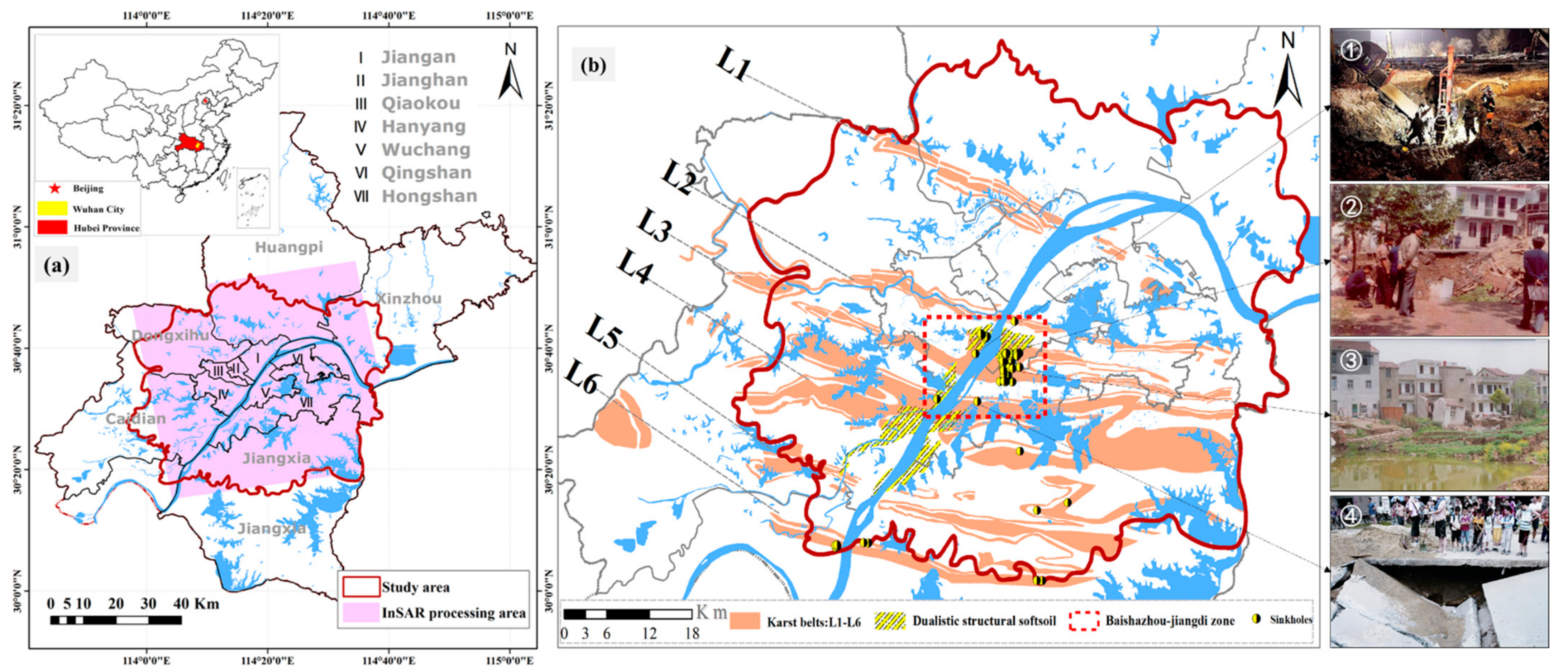
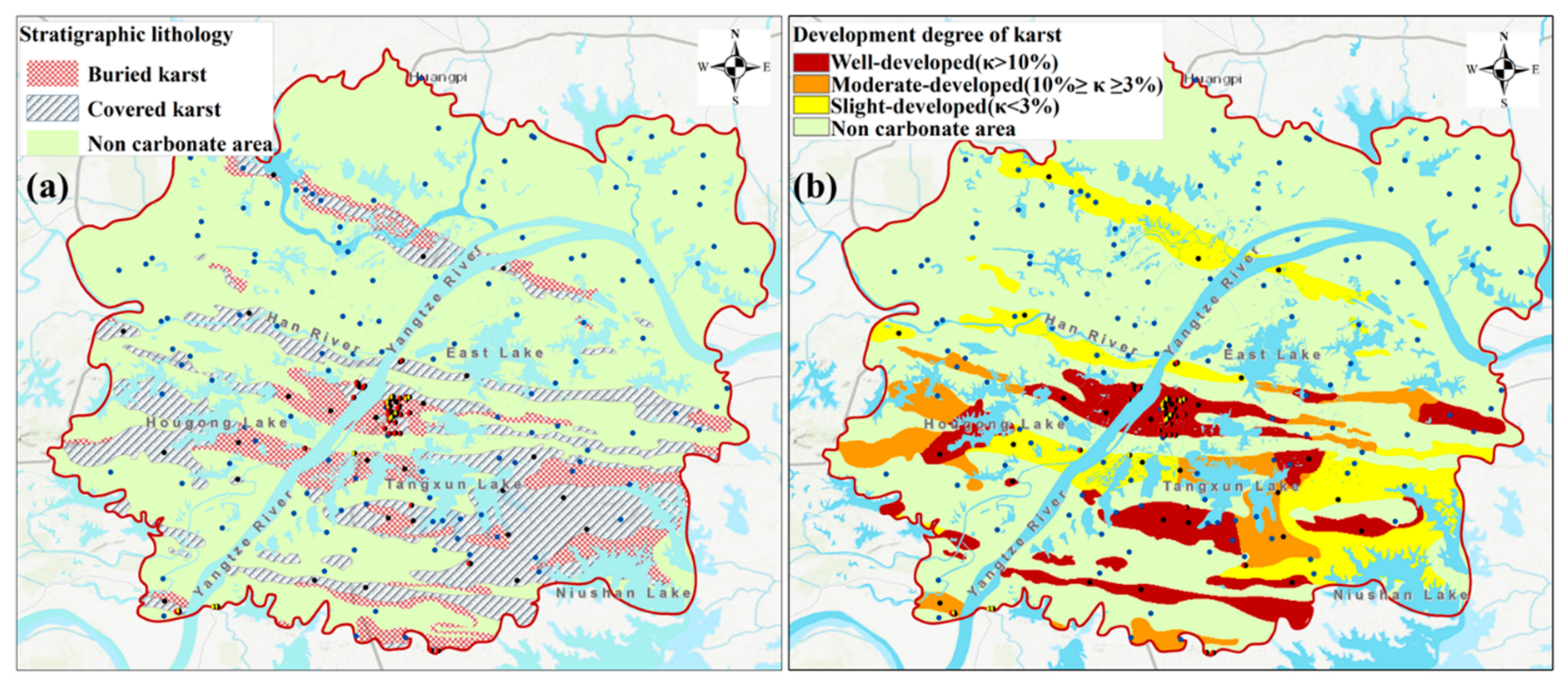

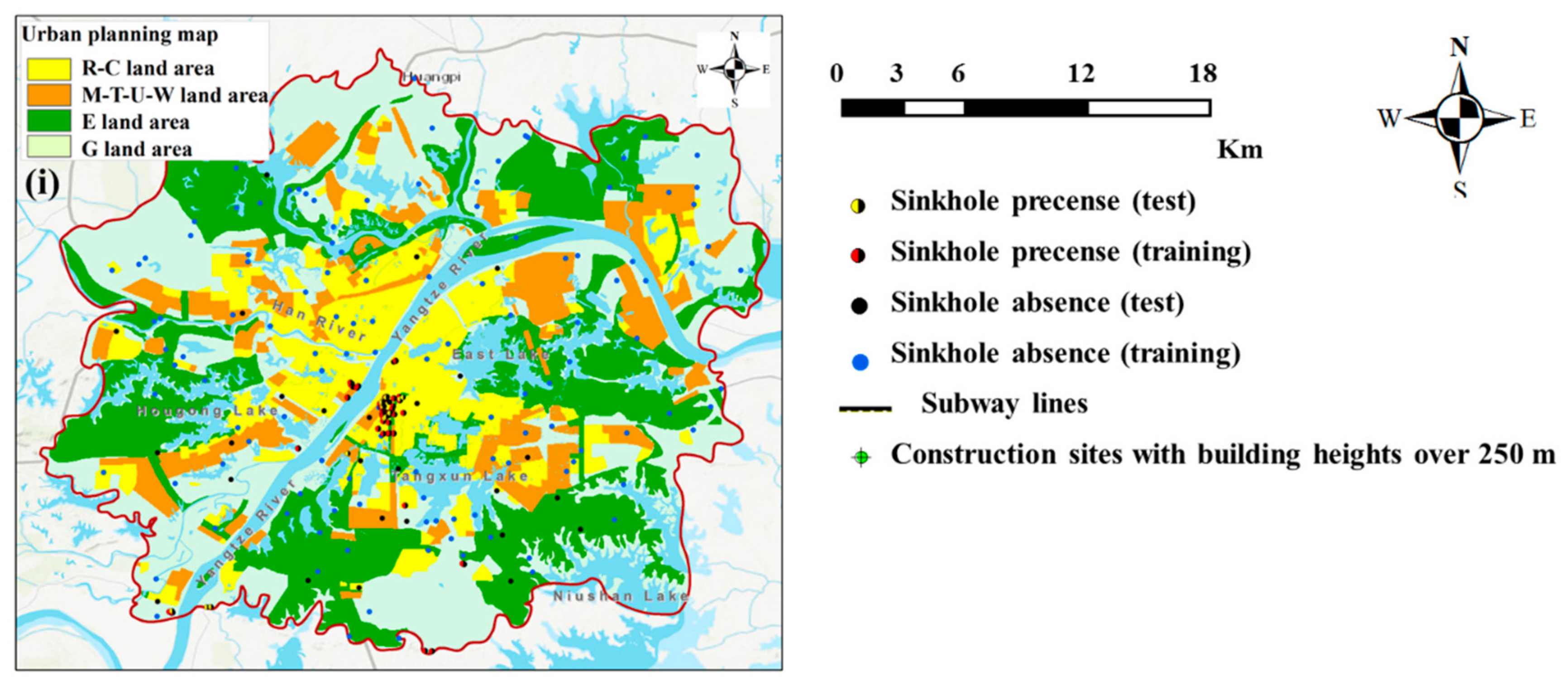
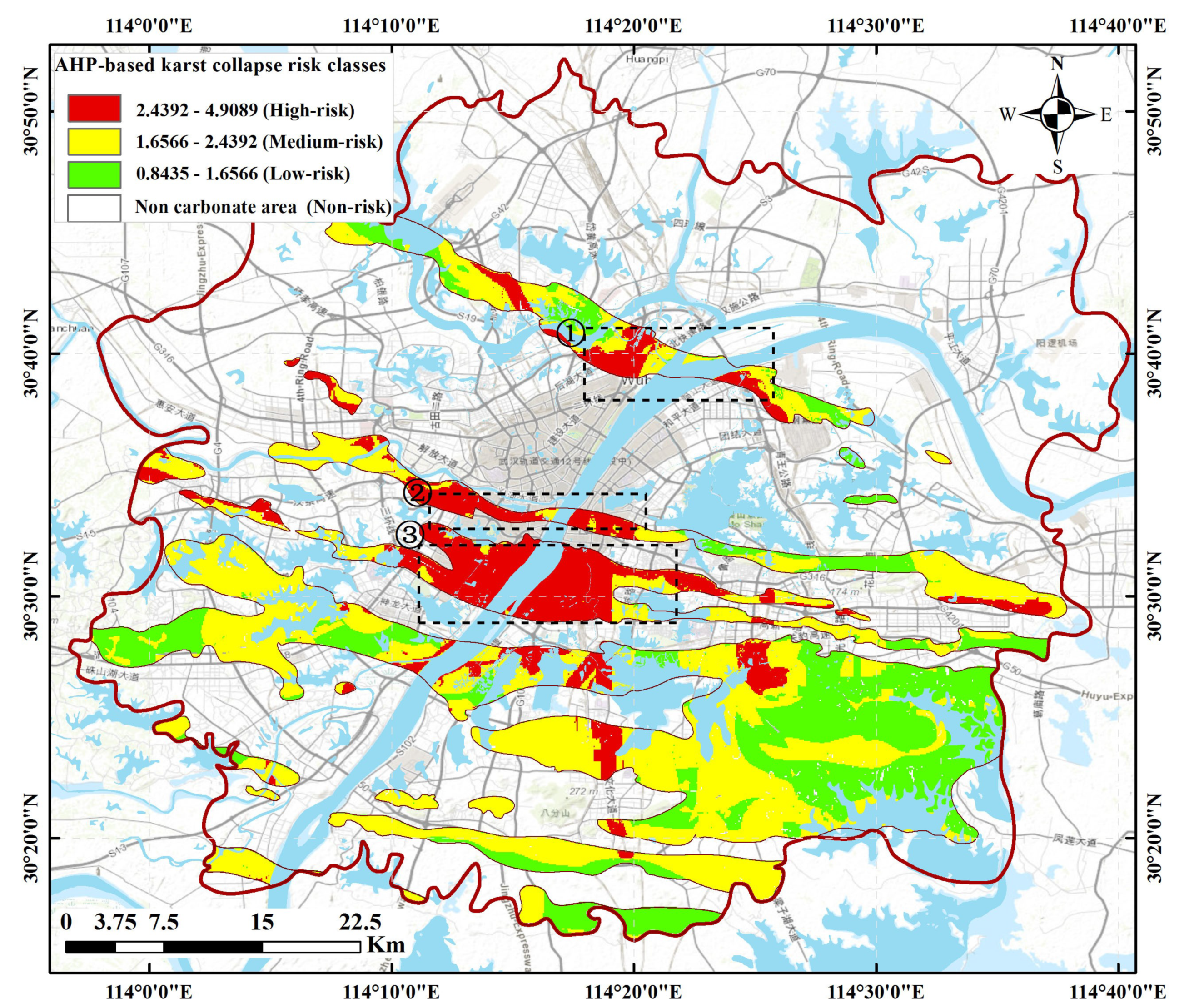
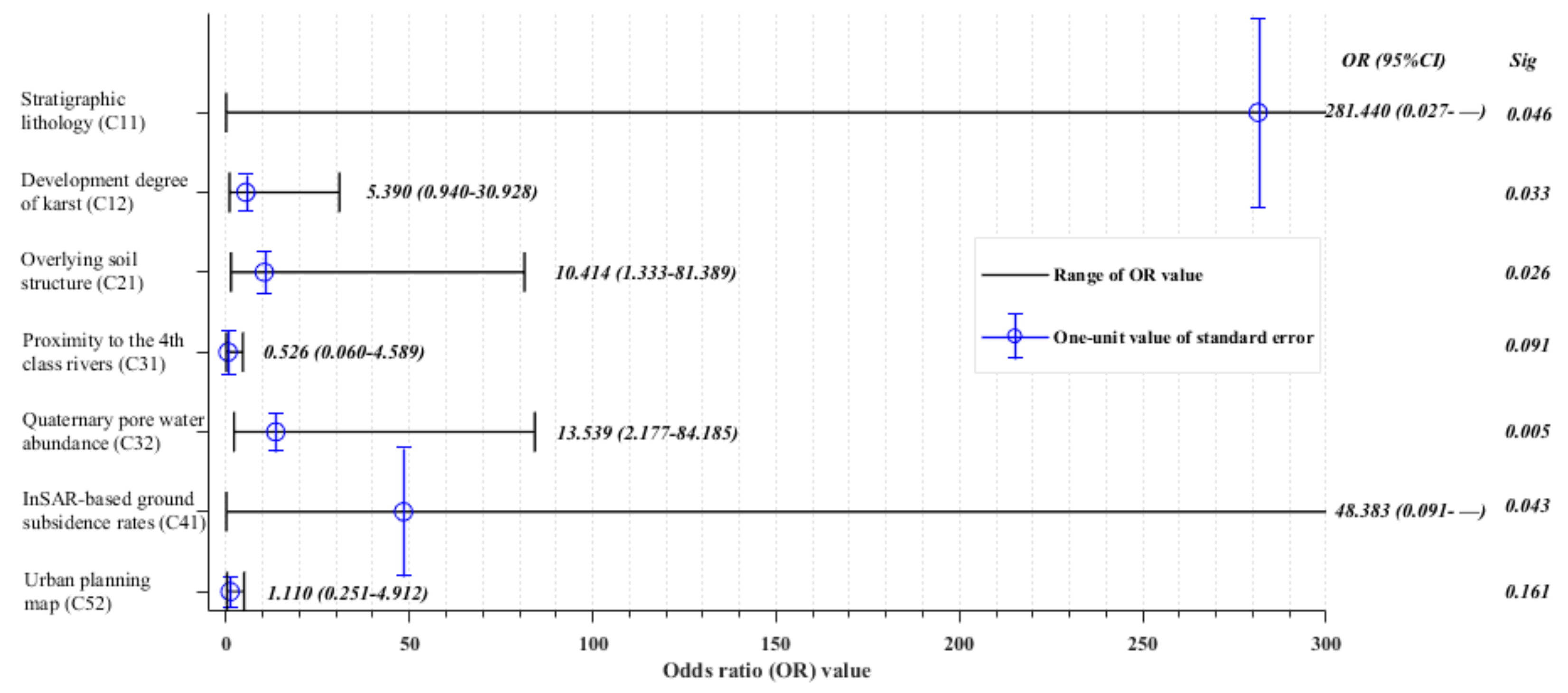
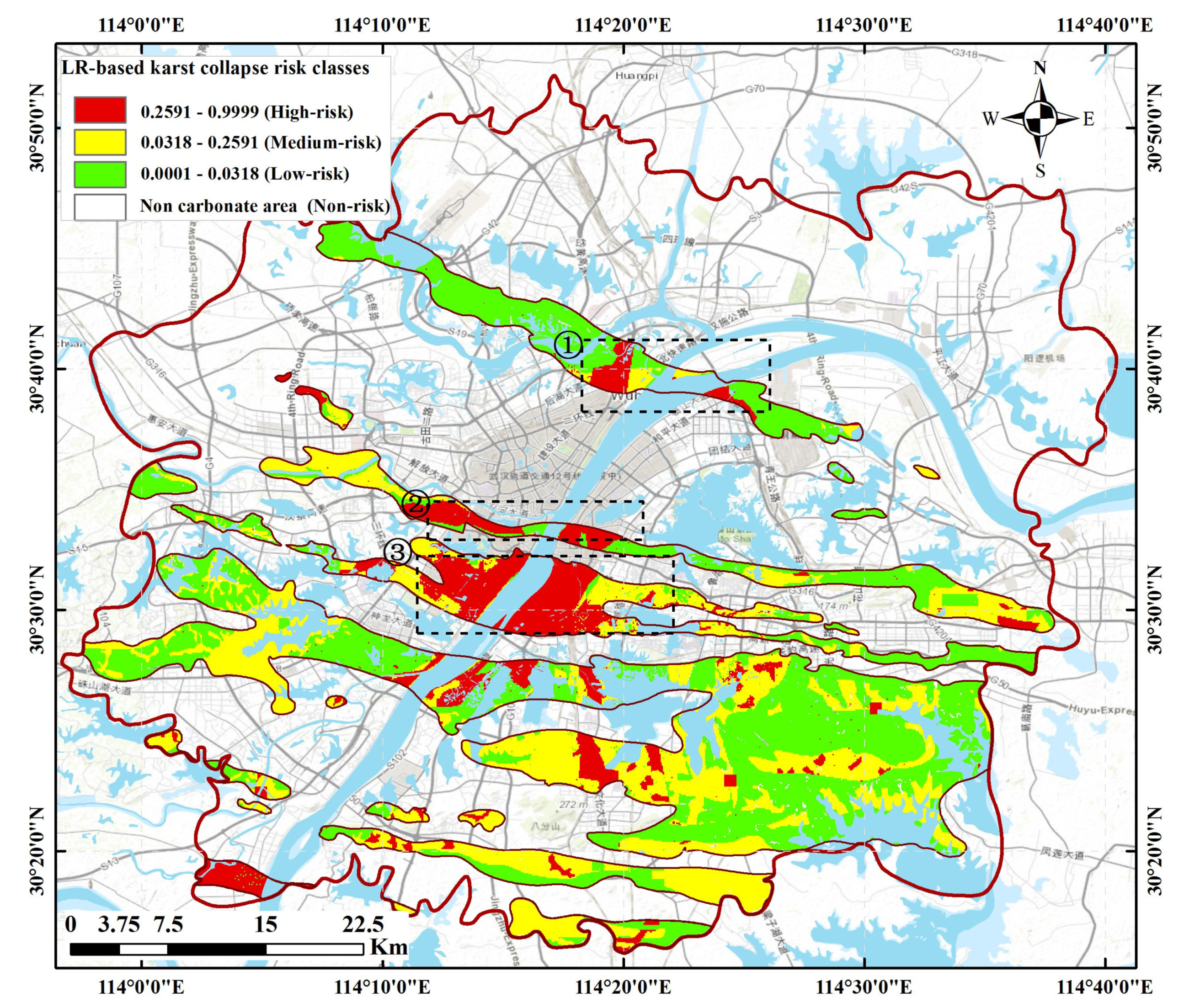
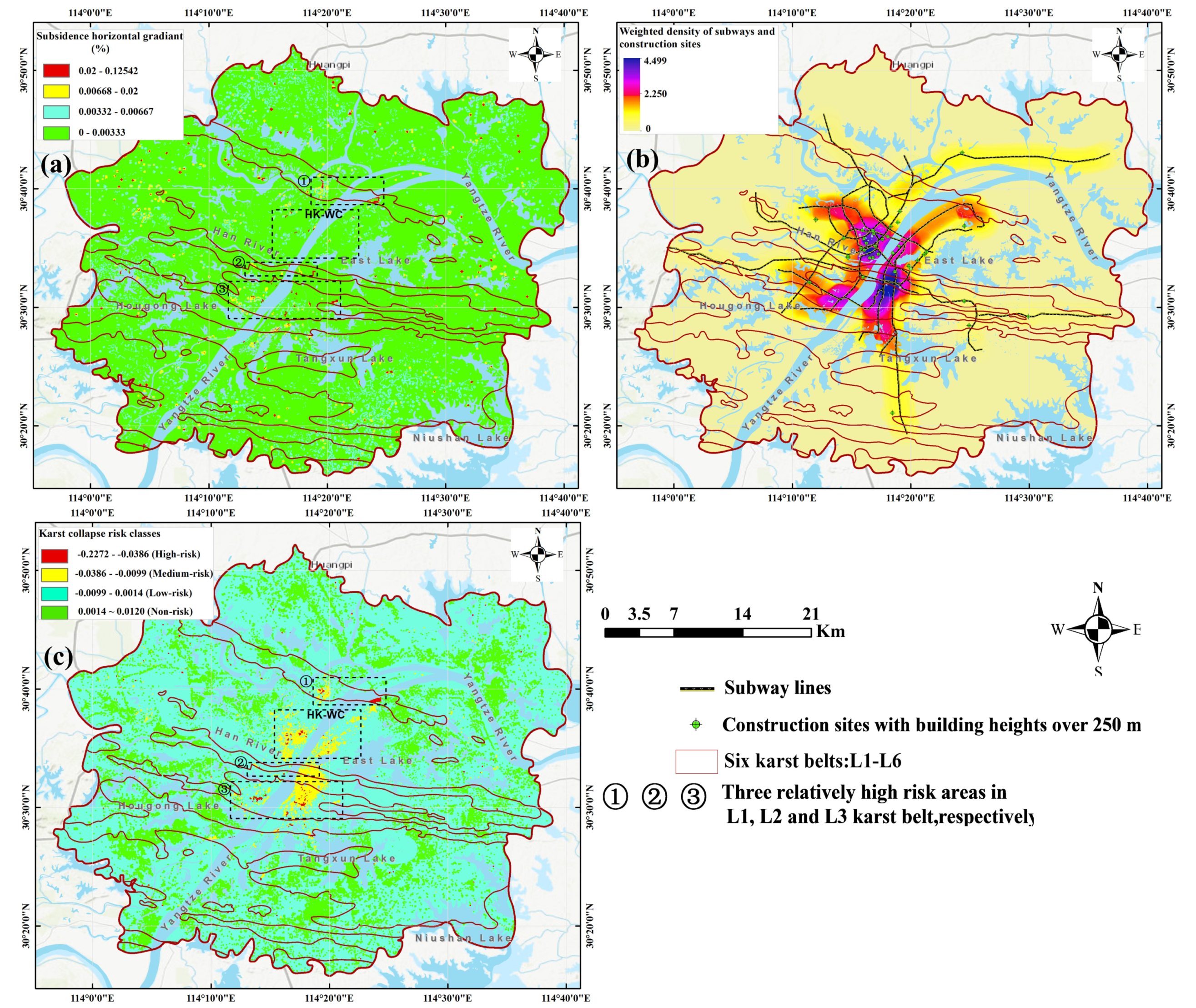

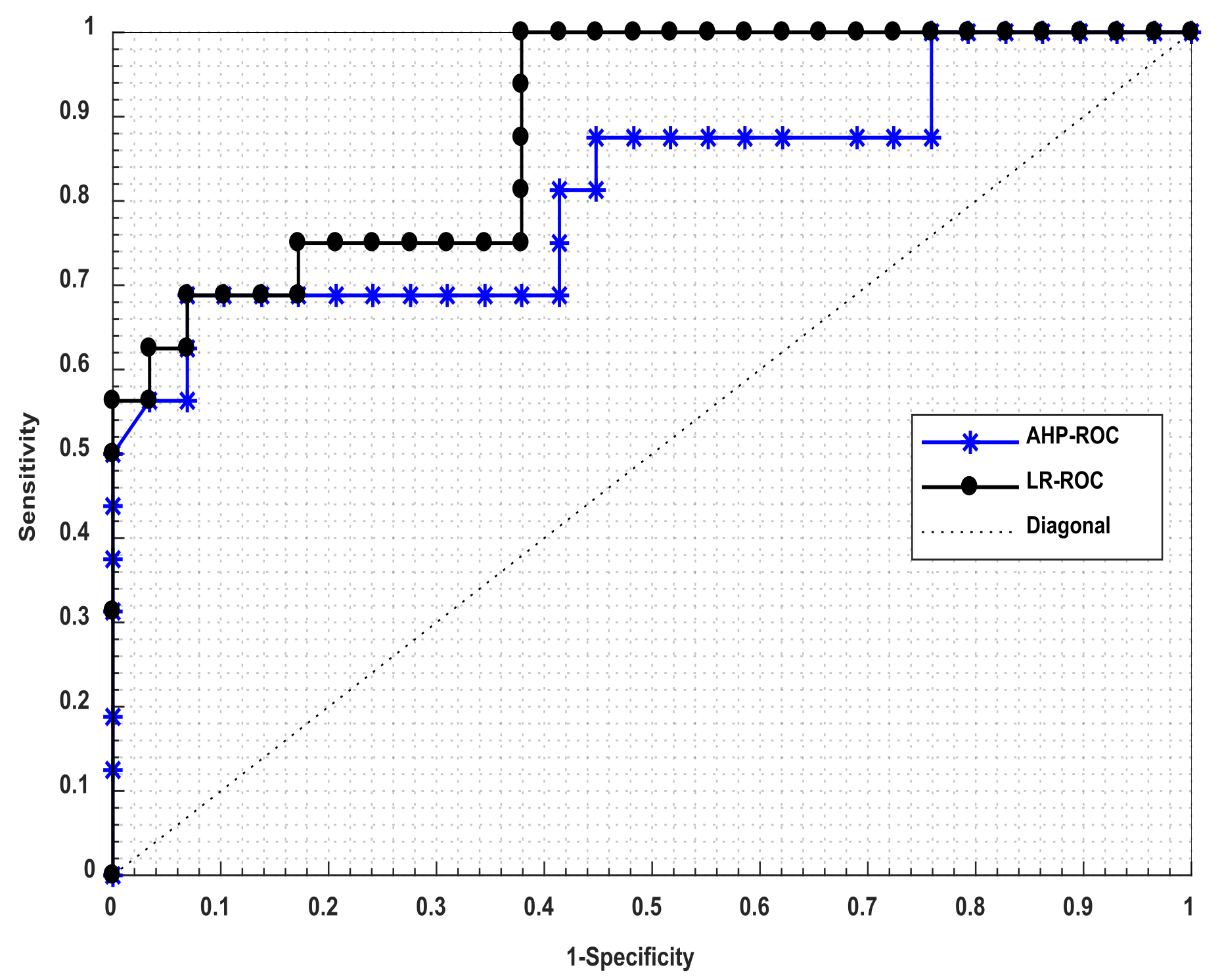
| Karst Collapse Evaluators | Influence Grading and Assignment | |||||
|---|---|---|---|---|---|---|
| Criterion Layer | Factor Layer | High | Medium | Low | Non-Prone | |
| M = 5 | M = 3 | M = 2 | M = 1 | |||
| Geological environment intrinsic conditions | Karst geology conditions (B1) | Stratigraphic lithology (C11) | Covered karst | Buried karst | - | Non carbonate area (M = 0) |
| Development degree of karst (C12) | (well-developed) | (Moderate developed) | (Slight-developed) | Non carbonate area (M = 0) | ||
| Overburden conditions (B2) | Overlying soil structure (C21) | Typical dualistic structure | Multi-layered soft soil structure | Buried and single-layer soil structure | - | |
| Overlying soil thickness (C22) | 30–40 m | 15–30 m | >40 m | <15 m | ||
| Hydrogeological conditions (B3) | Proximity to the 4th class rivers (C31) | <1000 m | 1000–3000 m | 3000–5000 m | >5000 m | |
| Quaternary pore water abundance (C32) | >1000 m3/d | 100–1000 m3/d | <100 m3/d | Non-aqueous group | ||
| Karst surface subsidence conditions (B4) | InSAR-based ground subsidence rates (C41) | −89.7–−5.8 mm/yr | −5.7–−1.3 mm/yr | −1.2–2.3 mm/yr | 2.4–29 mm/yr | |
| Extrinsic trigger conditions | Anthropological activities (B5) | Proximity to subway lines and construction sites (C51) | <500 m | 500–1000 m | 1000–2000 m | >2000 m |
| Urban planning map (C52) | R, C | M, T, U, W | G | E | ||
| Criterion Layer | Factor Layer | C11 | C12 | C21 | C22 | C31 | C32 | C41 | ||
| B1 | C11 | 1 | 1/2 | 0.3333 | 0.0782 | |||||
| C12 | 2 | 1 | 0.6667 | 0.1565 | ||||||
| B2 | C21 | 1 | 2 | 0.6667 | 0.2991 | |||||
| C22 | 1/2 | 1 | 0.3333 | 0.1495 | ||||||
| B3 | C31 | 1 | 1/5 | 0.1667 | 0.0137 | |||||
| C32 | 5 | 1 | 0.8333 | 0.0683 | ||||||
| B4 | C41 | 1 | 1 | 0.2347 | ||||||
| Criterion layerwith Respect to Target Layer (Sinkhole or Not) | ||||||||||
| Criteria Layer | B1 | B2 | B3 | B4 | Test Index | |||||
| B1 | 1 | 1/2 | 3 | 1 | 0.2347 | = 4.0042 | ||||
| B2 | 2 | 1 | 5 | 2 | 0.4486 | |||||
| B3 | 1/3 | 1/5 | 1 | 1/3 | 0.082 | CI = 0.0014, CR = 0.0016 Consistency test passed | ||||
| B4 | 1 | 1/2 | 3 | 1 | 0.2347 | |||||
| Risk Evaluator | B5 | Factor Layer | C51 | C51 | ||||
|---|---|---|---|---|---|---|---|---|
| B5 | 1 | 1/2 | 0.3333 | C51 | 1 | 5 | 0.8333 | 0.2777 |
| C52 | 1/5 | 1 | 0.1667 | 0.0556 | ||||
| SusAHP | 2 | 1 | 0.6667 | 1 | 0.6667 |
| Evaluation Indicators | Influence Grading | Category Area (km2) | No. of Sinkholes | Evaluation Indicators | Influence Grading | Category Area (km2) | No. of Sinkholes | ||
|---|---|---|---|---|---|---|---|---|---|
| Stratigraphic lithology (C11) | Covered karst | 675.386 | 52 | 0.7113 | Quaternary pore water abundance (C32) | >1000 m3/d | 299.246 | 12 | 0.4236 |
| Buried karst | 343.594 | 32 | 0.7655 | 100–1000 m3/d | 239.509 | 56 | 0.9211 | ||
| Non carbonate area | 2553.428 | 0 | −1 | <100 m3/d | 766.762 | 15 | −0.1714 | ||
| Development degree of karst (C12) | (well-developed) | 317.358 | 72 | 0.9179 | Non-aqueous group | 2266.890 | 1 | −0.9817 | |
| (Moderate developed) | 209.871 | 10 | 0.5187 | InSAR-based ground subsidence rates (C41) | [−89.7–−5.8] | 18.922 | 17 | 0.9973 | |
| (Slight-developed) | 433.358 | 2 | −0.8075 | [−5.7–−1.3] | 152.928 | 41 | 0.9343 | ||
| Non carbonate area | 2611.821 | 0 | −1 | [−1.2–2.3] | 2823.822 | 24 | −0.6440 | ||
| Overlying soil structure (C21) | Typical dualistic structure | 101.631 | 65 | 0.9864 | [2.4–29] | 576.736 | 2 | −0.8555 | |
| Multi-layered soft soil structure | 871.090 | 7 | −0.6636 | Proximity to subway lines and construction sites (C51) | <500 m | 372.673 | 46 | 0.8290 | |
| Buried and single-layer soil structure | 2599.687 | 12 | −0.8074 | 500–1000 m | 302.405 | 27 | 0.7544 | ||
| Overlying soil thickness (C22) | <15 m | 842.408 | 6 | −0.7021 | 1000–2000 m | 447.687 | 0 | −1.0000 | |
| 15–30 m | 1497.982 | 15 | −0.5799 | >2000 m | 2449.643 | 11 | −0.8127 | ||
| 30–40 m | 751.259 | 59 | 0.7175 | Urban planning map (C52) | M, T, U, W | 445.662 | 7 | −0.3373 | |
| >40 m | 480.759 | 4 | −0.6516 | R, C | 526.281 | 59 | 0.8093 | ||
| Proximity to the 4th class rivers (C31) | <1000 m | 648.032 | 24 | 0.3739 | G | 1539.057 | 11 | −0.7010 | |
| 1000–3000 m | 693.538 | 50 | 0.6901 | E | 1061.407 | 7 | −0.7243 | ||
| 3000–5000 m | 567.284 | 5 | −0.6307 | ||||||
| >5000 m | 1663.473 | 5 | −0.8748 | ||||||
| Factor Layer | C11 | C12 | C21 | C31 | C32 | C41 | C52 |
|---|---|---|---|---|---|---|---|
| Stratigraphic lithology (C11) | 1.000 | −0.016 | 0.029 | −0.045 | 0.037 | 0.164 | 0.056 |
| Development degree of karst (C12) | 1.000 | 0.106 | 0.078 | 0.213 | 0.202 | −0.363 | |
| Overlying soil structure (C21) | 1.000 | −0.184 | 0.361 | 0.138 | −0.098 | ||
| Proximity to the 4th class rivers (C31) | 1.000 | −0.231 | −0.063 | 0.071 | |||
| Quaternary pore water abundance (C32) | 1.000 | 0.022 | −0.178 | ||||
| InSAR-based ground subsidence rates (C41) | 1.000 | −0.090 | |||||
| Urban planning map (C52) | 1.000 |
| Risk Level | ||||||
|---|---|---|---|---|---|---|
| AHP-Based | LR-Based | AHP-Based | LR-Based | AHP-Based | LR-Based | |
| Low-risk zone (I) | 30.7% | 49.6% | 0 | 0 | 0 | 0 |
| Medium-risk zone (II) | 51.6% | 36.0% | 3/16 | 1/16 | 0.363 | 0.174 |
| High-risk zone (III) | 17.7% | 14.4% | 13/16 | 15/16 | 4.590 | 6.510 |
Publisher’s Note: MDPI stays neutral with regard to jurisdictional claims in published maps and institutional affiliations. |
© 2021 by the authors. Licensee MDPI, Basel, Switzerland. This article is an open access article distributed under the terms and conditions of the Creative Commons Attribution (CC BY) license (https://creativecommons.org/licenses/by/4.0/).
Share and Cite
Hu, J.; Motagh, M.; Wang, J.; Qin, F.; Zhang, J.; Wu, W.; Han, Y. Karst Collapse Risk Zonation and Evaluation in Wuhan, China Based on Analytic Hierarchy Process, Logistic Regression, and InSAR Angular Distortion Approaches. Remote Sens. 2021, 13, 5063. https://doi.org/10.3390/rs13245063
Hu J, Motagh M, Wang J, Qin F, Zhang J, Wu W, Han Y. Karst Collapse Risk Zonation and Evaluation in Wuhan, China Based on Analytic Hierarchy Process, Logistic Regression, and InSAR Angular Distortion Approaches. Remote Sensing. 2021; 13(24):5063. https://doi.org/10.3390/rs13245063
Chicago/Turabian StyleHu, Jiyuan, Mahdi Motagh, Jiayao Wang, Fen Qin, Jianchen Zhang, Wenhao Wu, and Yakun Han. 2021. "Karst Collapse Risk Zonation and Evaluation in Wuhan, China Based on Analytic Hierarchy Process, Logistic Regression, and InSAR Angular Distortion Approaches" Remote Sensing 13, no. 24: 5063. https://doi.org/10.3390/rs13245063
APA StyleHu, J., Motagh, M., Wang, J., Qin, F., Zhang, J., Wu, W., & Han, Y. (2021). Karst Collapse Risk Zonation and Evaluation in Wuhan, China Based on Analytic Hierarchy Process, Logistic Regression, and InSAR Angular Distortion Approaches. Remote Sensing, 13(24), 5063. https://doi.org/10.3390/rs13245063







